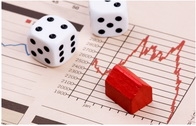Advertisement
CoreLogic Data Shows Third Consecutive Quarterly Decline in Negative Equity

CoreLogic, a provider of information, analytics and business services, has released negative equity data indicating a third consecutive quarterly decline in negative equity for residential properties. CoreLogic reports that 10.8 million, or 22.5 percent, of all residential properties with mortgages were in negative equity at the end of the third quarter of 2010, down from 11.0 million and 23 percent in the second quarter. This is due primarily to foreclosures of severely negative equity properties rather than an increase in home values.
During this year the number of borrowers in negative equity has declined by more than 500,000 borrowers. An additional 2.4 million borrowers were near negative equity with less than five percent equity in the third quarter. Together, negative equity and near-negative equity mortgages accounted for 27.5 percent of all residential properties with a mortgage nationwide.
Negative equity, often referred to as "underwater" or "upside down," means that borrowers owe more on their mortgages than their homes are worth. Negative equity can occur because of a decline in value, an increase in mortgage debt or a combination of both.
The full Q3 negative equity report, with charts and state-level data, is available here.
Data highlights
Negative equity remains concentrated in five states: Nevada, which had the highest negative equity percentage with 67 percent of all of its mortgaged properties underwater, followed by Arizona (49 percent), Florida (46 percent), Michigan (38 percent) and California (32 percent).
The largest declines in negative equity were concentrated in the hardest hit states. Alaska experienced the largest decline, falling 1.8 percentage points, followed by Nevada (-1.6), Arizona (-1.4), California (-1.2), and Florida (-0.9). Idaho and Alabama are the only states with a noticeable increase, which is not a surprise given they are currently the two top states for home price depreciation.
Although the level of negative equity is very high, there are still many homeowners with equity. Nearly half of New York borrowers have 50 percent or more positive equity, which leads the nation, followed by Hawaii (43 percent), Massachusetts (40 percent), Connecticut (39 percent) and Rhode Island (40 percent). There are some states that have barbell distributions of somewhat higher negative equity shares and higher percentages of borrowers with 50 percent or more positive equity. Rhode Island is the most extreme example as it ranks in the top 15 for both negative equity and for states with the highest share of 50 percent or more positive equity. To a lesser degree Massachusetts, New Jersey, Washington, D.C. and California exhibit similar trends.
According to the Census, the Q3 2010 homeownership rate was 66.9 percent, down from a peak of 69.2 percent in Q4 2004. The Census definition of homeownership includes homeowners in negative equity. However, homeowners in negative equity are not likely to behave similarly to homeowners with equity, because their financial interest (the equity) has disappeared and has only a small prospect of returning soon given price trends. The lack of equity means upside down homeowners are not likely to maintain and improve their property and are more likely to behave like renters.
An alternative definition of homeownership is to exclude owners with negative equity, which nets the effective homeownership rate. Adjusting for severe negative equity of 25 percent or more reveals that the effective homeownership rate as of Q3 was 62.4 percent or 4.5 percentage points lower than the official rate. Removing all negative equity homeowners reveals an effective homeownership rate of 56.6 percent or over 10 percentage points lower than the official rate.
At low shares of negative equity, the pre-foreclosure rate is higher for borrowers with more expensive homes (above $500,000) than for borrowers with low to moderately priced homes (between $100,000 and $300,000). Interestingly, once in deep negative equity, the relationship reverses with the low to moderately priced homes exhibiting fairly higher pre-foreclosure rates.
The aggregate level of negative equity declined to $744 billion, which is a three-percent decline from Q2 2010 and a seven-percent decline from the end of 2009 when it stood at $800 billion.
"Negative equity is a primary factor holding back the housing market and broader economy. The good news is that negative equity is slowly declining, but the bad news is that price declines are accelerating, which may put a stop to or reverse the recent improvement in negative equity," said Mark Fleming, chief economist with CoreLogic.
For more information visit www.corelogic.com.
About the author




